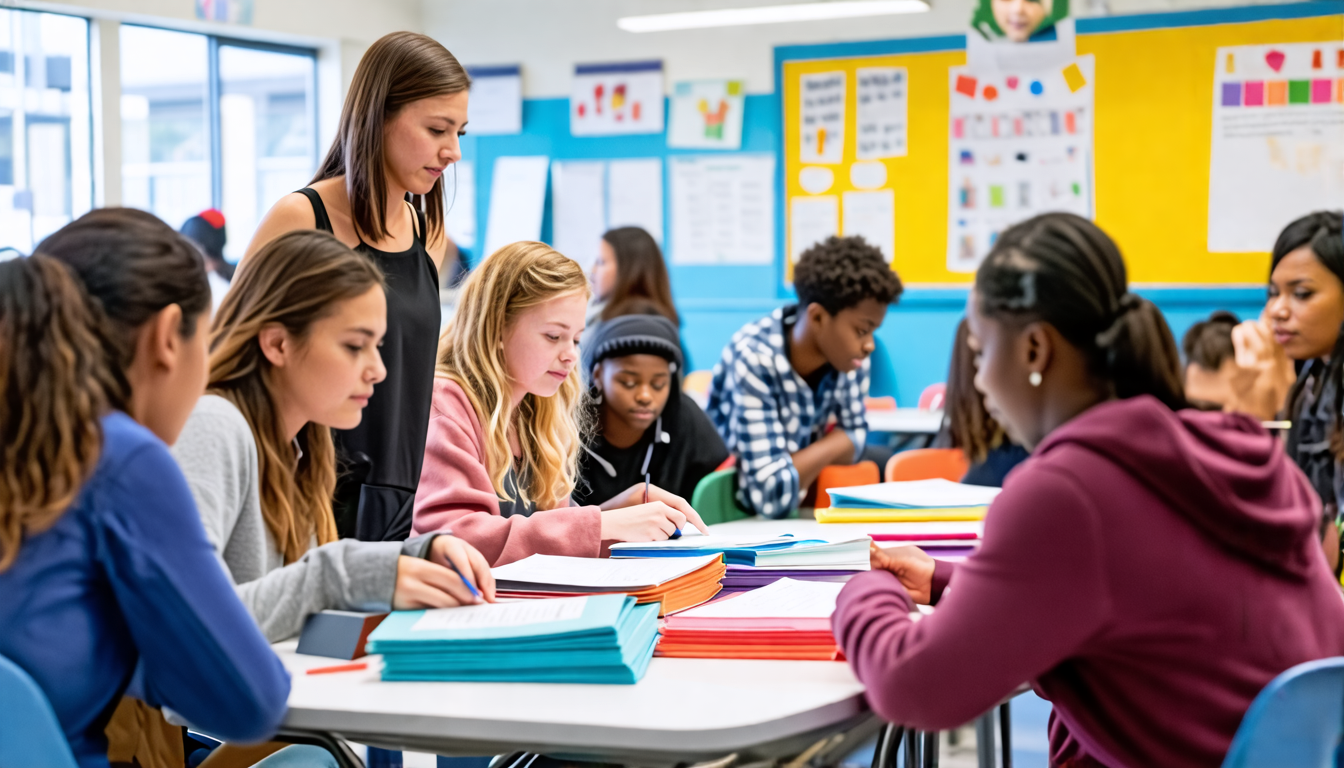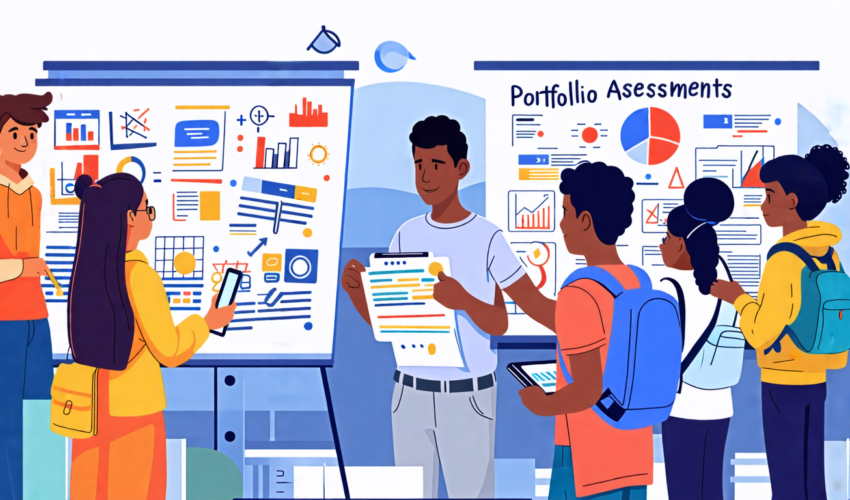In the dynamic world of education, where traditional evaluation methods often fall short of capturing a student’s comprehensive abilities, portfolio assessment emerges as a transformative approach. This innovative assessment method involves collecting a curated set of a student’s work that demonstrates learning progress, skills, and achievements over time. As educational paradigms shift towards more personalized and holistic models, portfolio assessments are gaining traction as a vital tool in modern education systems. By focusing on student-led work, these assessments allow educators to cater to diverse learning needs and preferences, offering insights beyond standard testing metrics. This article delves into the manifold benefits of portfolio assessment in education, examining how they enhance personalized learning, boost student engagement, and provide a detailed view of academic growth, while also offering practical strategies for successful implementation amidst potential challenges.
Introduction to Portfolio Assessment in Education
Portfolio assessment represents a transformative approach within the contemporary educational landscape, emphasizing a holistic evaluation of a student’s capabilities, achievements, and growth over time. Unlike traditional assessments, which often rely on standardized tests or one-time evaluations, portfolio assessment allows students to showcase a diverse array of work that collectively demonstrates their learning journey and achievements.
At its core, a portfolio assessment is a compilation of student work that provides an in-depth view of a student’s learning process, progress, and accomplishments across various subjects or specific competencies. These portfolios are not merely random collections; instead, they are carefully curated by students under the guidance of educators to include works that best reflect their understanding and mastery of the subjects at hand. This method of assessment is increasingly being adopted in educational systems due to its ability to address different learning styles and provide richer, more personalized feedback.
As education systems evolve to meet the needs of diverse learners and adapt to new educational philosophies, the growing trend of portfolio assessments cannot be overlooked. Educators argue that this method not only evaluates knowledge more comprehensively than exams but also nurtures critical skills such as self-assessment, reflection, and independent thinking, which are crucial in today’s rapidly changing world.
In recent years, portfolio assessments have gained traction globally, with schools and educational institutions incorporating them into their evaluative practices. This shift is largely driven by a recognition that education should focus on developing a wide range of competencies and skills rather than merely achieving high scores on a standardized test. Furthermore, as digital technology continues to revolutionize educational methodologies, e-portfolios—digital versions of these assessments—have become increasingly popular, adding a layer of convenience and accessibility to the traditional portfolio model.
This article delves into the numerous benefits of portfolio assessment, particularly how it can be a significant asset to both educators and students by fostering a more engaged, personalized, and meaningful learning experience. The focus is to unpack these benefits and illustrate how portfolio assessment can enhance educational outcomes, positioning it as a vital component of effective contemporary teaching and learning.

Key Benefits of Portfolio Assessment in Education
Portfolio assessment has emerged as a revolutionary method in the field of education, offering a host of benefits that cater to both educators and students. One of the primary advantages of portfolio assessment is its ability to foster personalized learning, which is essential in addressing the diverse needs of students. Traditional assessments often focus on a uniform standard, but portfolio assessments allow students to showcase their unique skills and learning pathways.
Through portfolio assessments, educators can better understand a student’s individual learning styles and preferences. This insight enables instructors to tailor their teaching methods to better align with each student’s needs, thereby enhancing the learning experience. Personalized learning empowers students to take charge of their education, promoting self-directed learning and critical thinking skills.
Moreover, portfolio assessments significantly enhance student engagement and ownership of their own learning process. Unlike traditional tests, where students may feel pressured or anxious, portfolios place students in active roles, allowing them to exhibit their work, reflect on their learning journey, and set future goals. This active participation increases motivation and investment in their education as students feel more accountable and proud of their achievements.
Another substantial benefit of portfolio assessments is their ability to provide a comprehensive view of a student’s progress over time. Unlike snapshot assessments, which offer a limited perspective based on a single moment, portfolios compile work from various periods, displaying a student’s growth and changes in understanding. This longitudinal approach allows educators to recognize patterns, strengths, and areas needing improvement, leading to more accurate and meaningful evaluations.
The comprehensive nature of portfolio assessments also facilitates more authentic evaluation methods. By documenting and assessing a student’s learning journey holistically, educators can draw from an array of evidence, including projects, drafts, final products, and reflections. This diversity of evaluation criteria permits a more nuanced understanding of student capabilities, potentially leading to fairer and more representative grading.
Furthermore, portfolio assessments encourage a blend of both formative and summative assessment methods. They can be used to provide ongoing feedback throughout the learning process (formative) and as culminating demonstrations of student learning (summative). This dual-purpose function allows educators to adapt instruction based on real-time data while also preparing students for comprehensive end-of-term evaluations.
Additionally, portfolio assessments often incorporate a reflective component, where students analyze their own work and learning strategies. This metacognitive exercise is vital in developing lifelong learning skills, enabling students to assess their progress, recognize strengths, and identify areas for improvement. As students engage in reflection, they cultivate an understanding of how they learn best, promoting their autonomy as learners.
Innovative as they are, portfolio assessments align well with contemporary educational objectives, such as fostering critical thinking, creativity, and problem-solving abilities. By allowing students to explore and present their learning in varied ways, portfolios support diverse expressions of knowledge and competencies, adhering to holistic approaches in education that produce well-rounded individuals.
Incorporating technology into portfolio assessments can further amplify their effectiveness, with digital portfolios allowing students to easily compile and showcase their work online. This accessibility not only facilitates easier organization and review but also prepares students for the digital skills required in today’s world.
In conclusion, the implementation of portfolio assessment in education serves as a catalytic force for enhancing the personalized learning experience, increasing student engagement and ownership, and providing a fuller, richer view of student progress and skills over time.

Implementing Portfolio Assessment: Best Practices and Challenges
Incorporating portfolio assessment into educational environments is a transformative process that can yield significant benefits for both educators and students. To ensure successful implementation, it is critical to understand the best practices that facilitate this integration while also recognizing and addressing the potential challenges.
Effective Strategies for Integrating Portfolio Assessments
One of the key strategies for successful implementation of portfolio assessment is clear goal-setting. Educators should define the purpose of the portfolio and the specific skills or knowledge it aims to showcase. This can help guide students in selecting artifacts that meaningfully represent their learning journeys. Furthermore, developing a structured framework, including predefined criteria and rubrics, provides students with clear expectations and helps streamline the assessment process for educators.
Another effective strategy is the use of digital platforms and tools to support portfolio assessments. Leveraging technology can enhance accessibility and organization, allowing both educators and students to easily collect, manage, and review portfolio entries. Platforms such as Google Classroom, Seesaw, or dedicated e-portfolio tools can facilitate collaboration, feedback, and sharing with peers and parents.
Ongoing professional development for educators is also crucial. Training sessions on how to effectively use portfolio assessments, evaluate diverse types of evidence, and provide constructive feedback can empower teachers to maximize the benefits of this assessment method. Moreover, involving students in the assessment process by encouraging self-reflection and goal-setting enables them to take ownership of their learning. This student-centered approach not only boosts engagement but also enhances critical thinking and self-regulation skills.
Challenges in Implementing Portfolio Assessments and Solutions
Despite the numerous advantages, implementing portfolio assessment is not without its challenges. One common challenge educators face is time management. The process of reviewing and providing feedback on student portfolios can be time-consuming compared to traditional assessment methods. To mitigate this, schools can adopt staggered submission deadlines or focus on selective assessments for significant assignments, allowing educators to manage their workload more effectively.
Another challenge is ensuring consistency and objectivity in assessment. It is essential to establish clear, consistent criteria across different classrooms and subjects to maintain fair evaluations. Regular calibration sessions among educators can help align assessment standards and reduce subjectivity.
Integrating portfolio assessment requires a cultural shift within educational institutions, often involving changes in mindset, roles, and practices. Resistance to change can be addressed by involving all stakeholders—administrators, educators, students, and parents—from the onset. Open communication regarding the benefits and intended outcomes can increase buy-in and support. Additionally, pilot programs can serve as valuable starting points, allowing schools to experiment with portfolio assessments on a smaller scale and refine their approaches before wider implementation.
The Importance of Portfolio Assessments in Education
Portfolio assessments hold immense potential in enhancing educational outcomes and preparing students for future learning experiences. By focusing on students’ strengths and individual progress, educators can promote a more personalized and inclusive approach to learning. When implemented thoughtfully, portfolio assessments can serve as powerful tools to capture the depth and breadth of student learning, offering insights that are often obscured by traditional testing methods.
In conclusion, while there are challenges associated with implementing portfolio assessments, the rewards are well worth the effort. By employing best practices and proactively addressing hurdles, educators can harness the full potential of portfolios to enrich the learning experience and equip students with the skills necessary for lifelong learning and success.
In conclusion, portfolio assessment stands as a transformative approach in the educational landscape, offering a multitude of benefits that extend beyond traditional forms of evaluation. By fostering personalized learning, portfolio assessments cater to the unique needs and capabilities of each student, allowing them to take ownership of their educational journey. This method not only enhances student engagement but also encourages a deeper understanding and application of knowledge. Furthermore, the longitudinal insights provided by portfolio assessments offer educators a comprehensive view of student progress, facilitating more nuanced and accurate evaluations. While implementing portfolio assessments presents certain challenges, such as the need for effective integration strategies and the potential for increased workload, these can be mitigated through thoughtful planning and resource allocation. Ultimately, portfolio assessments are an invaluable tool in equipping students with the skills and competencies necessary for future challenges, ensuring a more personalized and meaningful educational experience. Embracing this approach will undoubtedly enrich educational outcomes, preparing students to become active, lifelong learners in an ever-evolving world.

